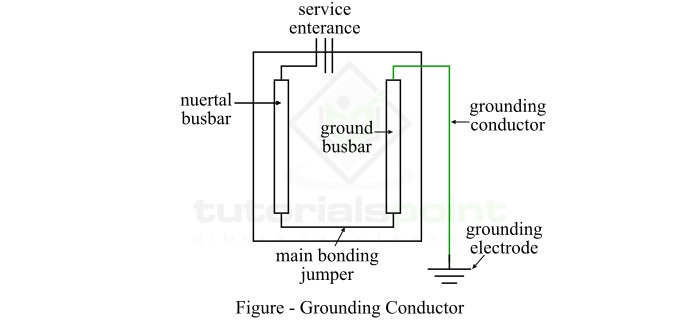
 Data Structure
Data Structure Networking
Networking RDBMS
RDBMS Operating System
Operating System Java
Java MS Excel
MS Excel iOS
iOS HTML
HTML CSS
CSS Android
Android Python
Python C Programming
C Programming C++
C++ C#
C# MongoDB
MongoDB MySQL
MySQL Javascript
Javascript PHP
PHP
- Selected Reading
- UPSC IAS Exams Notes
- Developer's Best Practices
- Questions and Answers
- Effective Resume Writing
- HR Interview Questions
- Computer Glossary
- Who is Who
What is Grounding Conductor and How to Calculate its Size?
Grounding, also called earthing, is defined as a process of connecting non-current carrying parts like metallic frame of electrical device or some electrical parts of power system like neutral point of a star-connected system to earth or ground.
The main purpose of doing grounding in electrical systems is to prevent accidents and damage to the equipment of the system.
In this article, we shall discuss about grounding conductor and how to calculate right size of the grounding conductor according to the requirement
What is a Grounding Conductor?
A wire or conductor in an electrical system which is intentionally connected to the ground or earth is called grounding conductor. The grounding conductor is also known as ground wire or earth wire.
One end of the grounding conductor is generally connected to the case or outer metallic body of an electrical appliance, and the other end is connected to the ground. The primary function of the grounding conductor is to provide protection against accidents and damages due to faults in the electrical systems. Under normal operating conditions, no current flows through the ground wire.

The grounding conductor is so chosen that it can provide a path of very low resistance for the flow of high electric currents under faulty conditions. Therefore, the grounding conductor provides an alternate path of low resistance for the flow of fault current.
Hence, when there is a fault in an electrical appliance and the leakage currents are circulating through the metallic body of the appliance. If we provided a grounding conductor connected between the appliance and earth, then the leakage currents will flow through the ground wire instead of a human body or other non-current carrying parts of the appliance.
Color Coding of Grounding Conductor
In most of the cases, the grounding conductor is made up of a bare wire, and does not have any insulation coating of any color. But, in various applications, the insulated wire is used as a grounding conductor, the color of insulation coating of this wire should be green or greenyellow stripes.
According to various standards like IEC-60446, BS-7671, AS/NZS 3000:2007 3.8.3, etc. the color of insulation coating of wire used as a grounding conductor is green-yellow stripes. However, in some countries like India, Canada, and Brazil, the wire with green colored insulation are used as a grounding conductor.
Calculation of the Size of a Grounding Conductor
As we discussed in above sections that the ground conductor is meant for providing a path of very low impedance in the flow of electric current under fault condition. Therefore, it reduces the voltage of the body or case of an electrical appliance to zero. Thus, we have to select a wire of suitable size for the grounding conductor for a particular application which depends upon the fault current rating of the system.
In practical applications, it is a usual practice to select the size of a grounding conductor whose current capacity should not be less than 25% of the capacity of the phase conductor or overcurrent device.
The following table helps us to select a minimum size of a grounding conductor according to NEC (National Electrical Code) ?
| NEC Table 250.122 - Minimum Size Equipment Grounding Conductor | ||
|---|---|---|
|
Rating or Setting of Automatic Overcurrent Device in the Circuit Ahead of Equipment, Conduit, etc. Not Exceeding (Ampere) |
Conductor Size (AWG or kcmil) | |
| Copper Wire Size | Aluminum or Copper-Clad Aluminum | |
| 15 | 14(AWG) | 12(AWG) |
| 20 | 12 | 10 |
| 60 | 10 | 8 |
| 100 | 8 | 6 |
| 200 | 6 | 4 |
| 300 | 4 | 2 |
| 400 | 3 | 1 |
| 500 | 2 | 1/0 |
| 600 | 1 | 2/0 |
| 800 | 1/0 | 3/0 |
| 1000 | 2/0 | 4/0 |
| 1200 | 3/0 | 250 (kcmil) |
| 1600 | 4/0 | 350 |
| 2000 | 250 (kcmil) | 400 |
| 2500 | 350 | 600 |
| 3000 | 400 | 600 |
| 4000 | 500 | 750 |
| 5000 | 700 | 1200 |
| 6000 | 800 | 1200 |

